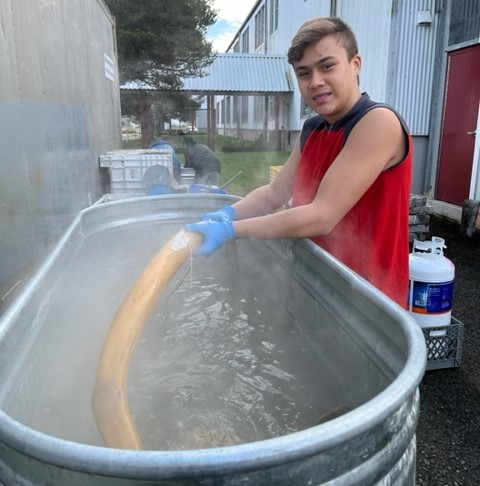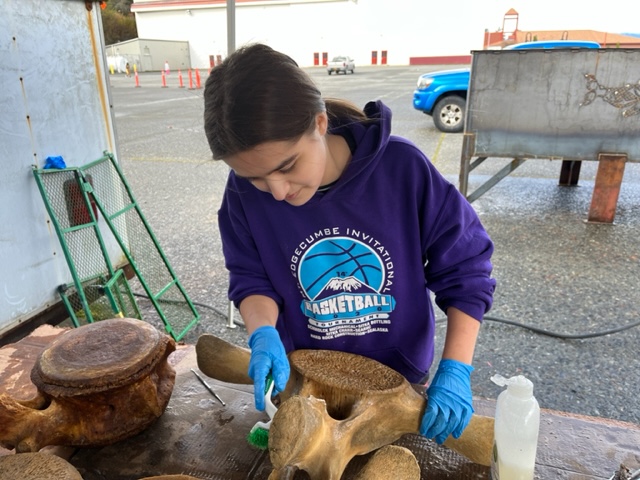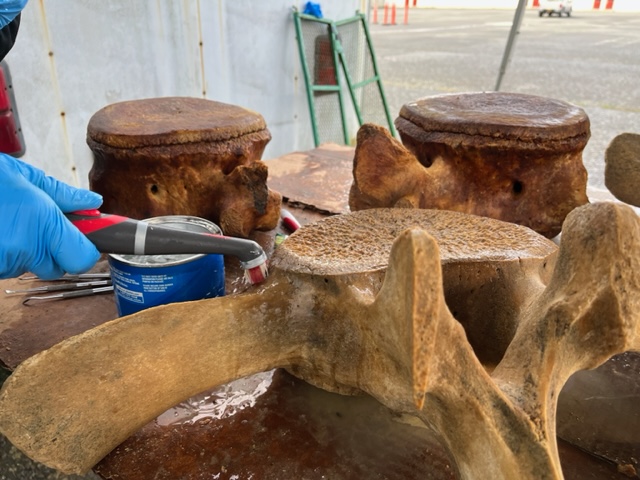
The smell of simmering whale bones wafted through the parking lot of Sitka’s UAS campus on Saturday (10-21-23). Students and volunteers are working on a project to rearticulate the skeleton of a juvenile humpback whale that washed up on Kruzof Island this spring – but first, they have to boil the bones.
In one corner of the parking lot, Sitka High student Jayson Miller stands over a steaming metal tub of simmering rib bones.
“I’m just stirring the whale bones,” he says.
He hoists one out to examine it — it’s as thick as a human arm. A few yards away, Sitka High employee Lisa Hanson and student Alice Ann Ricketts are scrubbing platter-sized vertebrae with electric toothbrushes.

“We’re trying to get off the black spots and make sure there’s like no slimy stuff on it,” Ricketts says, pointing out a few spots of dark mold on the porous surface of the vertebra.
This is the second time boiling these bones. Hanson says the first round, when the bones still had bits of tissue, was messier.
“Much more messy,” she says. “These don’t have — there’s just a little bit left on them. There’s no meat, no fat.”
Shannon Atkinson, a professor of fisheries and ocean sciences at University of Alaska-Fairbanks in Juneau, is helping to oversee the project, which is led by Sitka High teacher Stacy Golden and supported by UAS and the Sitka Sound Science Center. Atkinson says that the project is intended to be a learning experience for students – which means she gets to quiz them as they work. She lobs questions at Miller as he stirs his tub of bones.

“Sometimes we add some dish soap to it. And why would we do that?” she asks. “What’s in dish detergent that makes it clean things? What’s left on your plate after you’ve had a steak or something? Right, grease.”
Atkinson also worked on the 2012 rearticulation of an orca skeleton that now hangs in the Sitka Sound Science Center. She sees both projects as a way to honor the whales.
“What I realized from doing the orca is that the animal, while it may have not had a very long life, and obviously it got a little busted up during its life, but it is serving as such an ambassador for the species that it makes me really proud every time I walk in to see it,” Atkinson says.
When complete, Atkinson says this skeleton will be one of only a few rearticulated humpback whale skeletons in Alaska.
“Sitka is a very lucky community, to be able to have these kinds of projects,” she says. “And you just have to love a university that’s willing to let you boil whale bones – make whale soup – in its parking lot.”
There’s still a long way to go before these bones are ready to display. Once they’re clean, they’ll be soaked in ammonia to remove the last of the oil before assembly of the 160+ bones begins. But Atkinson says by fall 2024, Sitka High School should have a clean, fully-articulated humpback skeleton hanging in the commons.






























